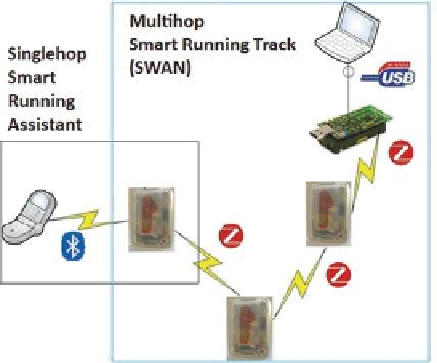Information Technology Reference
In-Depth Information
Fig. 12.1
Smart Running Track and Smart Running Assistant
on the second part of the scenario (involving sensor nodes and a laptop computer).
The first part (interconnection between a mobile phone and a sensor node) has been
since treated as a spin-off project - the Smart Running Assistant (Fig.
12.1
).
12.1.1
SRT Hardware
The hardware for Smart Running Track includes the following devices:
•
Shimmer Research SHIMMERs, some of them additionally equipped with
Shimmer Research's ECG and pulse oximetry sensing equipment (Fig.
12.2
).
Typically, a runner wears up to three SHIMMER nodes - one of which records
hip movements, one records ECG signals.
TelosB nodes, one per Smart Running Track deployment. A TelosB is plugged
•
into a laptop computer through its USB port, serving as a gateway between a
sensor network and the desktop Smart Running Track application.
A laptop computer running the SWAN (Sensor Wireless AcquisitioN) software,
•
which collects and processes the sensor data.
12.1.2
SRT Software
The software for the Smart Running Track is centered around a Java application
running on a desktop computer called the SWAN (Sensor Wireless Acquisition)
GUI. The application was developed using the NetBeans integrated environment
and the Swing API (for user interface; Fig.
12.3
).
When plugged into the USB port, a TelosB node registers itself as a serial port
(usually COM15 or COM16) through a USB serial driver. The SWAN can thus use

Search WWH ::

Custom Search